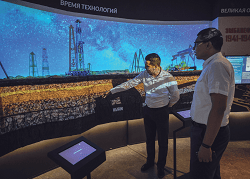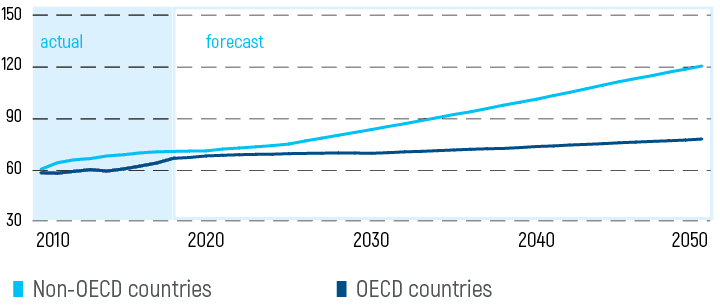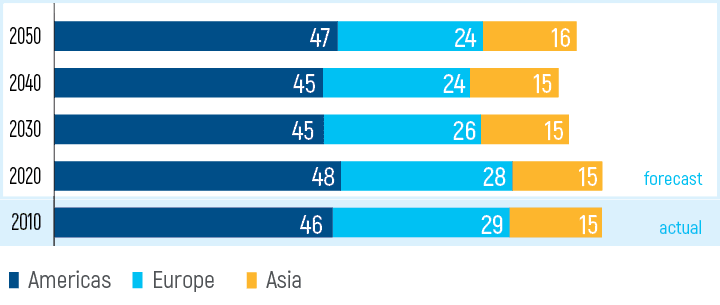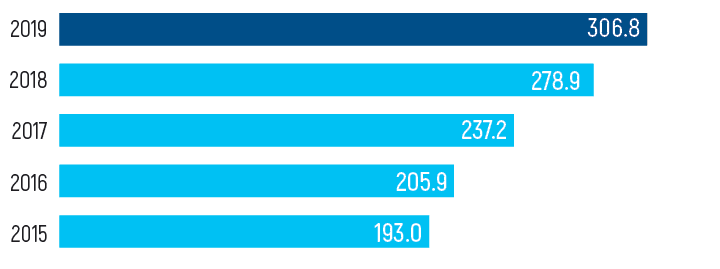Macroeconomics, global trends and internal drivers
Kazakhstan’s oil and gas industry
Kazakhstan’s wealth of hydrocarbon reserves make the oil and gas industry a key sector of the national economy. Kazakhstan has extensive hydrocarbon resources to support reserves growth. More than 60% of Kazakhstan’s territory is occupied by oil and gas areas of various sizes.
The oil and gas industry accounts for approximately 21% of Kazakhstan’s total GDP (in 2018). The crude oil and natural gas production sector attracted 50% of gross FDI inflows in 2019. The export of crude oil, natural gas, and petroleum products safeguards export revenues at a level of 64% of total exports in 2019 HS Code 2709 - crude oil and crude petroleum products derived from bituminous rocks, HS Code 2711 - other petroleum gases and gaseous hydrocarbons, HS Code 2710 - oil and petroleum products derived from bituminous rocks, other than crude ones..
As production expanded over the past decades, Kazakhstan has significantly consolidated its position in the global hydrocarbon market. In the medium and longer-term, Kazakhstan will continue to grow production.
According to the Information and Analytical Centre of Oil and Gas, 90.6 min tonnes of crude oil and gas condensate were produced in Kazakhstan in 2019, with a marginal change compared to 2018. Gas production was at 56.4 bln m3 in 2019, up by 1.7% year-on-year.
Kazakhstan has a modern and diversified oil and gas transportation, refining and processing infrastructure. Oil transportation is a strategic segment in KMG’s asset portfolio to maintain access to markets.
KMG has diversified hydrocarbon transportation routes and built a transportation infrastructure to support gas exports to China.
According to the Information and Analytical Centre of Oil and Gas of the Ministry of Energy, the refining volume at Kazakhstan refineries was 17.1 mln tonnes in 2019, a 4.4% increase year-on-year. The output of oil products increased by 15.5% year-on-year for petrol, 7.7% for diesel, and 63.2% for jet fuel. In the medium term, a surplus for oil products is expected in the domestic market, a positive driver for exports.
Source: Statistics Committee of the Ministry of National Economy of the Republic of Kazakhstan, the Information and Analytical Centre of Oil and Gas of the Ministry of Energy of the Republic of Kazakhstan
Source: The Information and Analytical Centre of Oil and Gas of the Ministry of Energy based on the data provided by transportation companies
Favourable economic conditions in Kazakhstan in 2019
Economic conditions in Kazakhstan are favourable given the expected positive economic growth in the medium-term, stable fiscal and monetary policies, and the government’s push for structural reforms. With a GDP of USD 179 bln in 2019, Kazakhstan is the largest economy in Central Asia, accounting for about 60% of the region’s GDP.
The national economy is resilient, with Kazakhstan demonstrating a sustainable economic growth rate of 4.2% on average over the past 10 years. GDP growth in 2019 was at 4.5%, outpacing the growth rates in 2014–2018.
In 2015, the NBK introduced inflation targeting and reduced inflation from a double-digit rate of 17.7% in July 2016 to 5.3% in December 2018 and 5.4% in December 2019, in line with the NBK’s inflation target of 4–6% for 2019–2021. In December 2019, inflation expectations were stable and close to underlying inflation.

Source: Statistics Committee of the Ministry of National Economy of the Republic of Kazakhstan
Source: Statistics Committee of the Ministry of National Economy of the Republic of Kazakhstan (CIS Key Indicators), Bloomberg (ratings as at 16 March 2020), Intracen (Kazakhstan’s foreign trade)
On 10 March 2020, the NBK made an unplanned decision on the base rate to maintain price stability amidst heightened external risks. The NBK increased the base rate to 12% with widened interest rate corridor to +/- 1.5 pp from 9.25% (interest rate corridor: +/- 1 pp).
In line with the inflation targeting regime, floating exchange rates were introduced in 2015. The NBK reserved the right to smooth out significant exchange rate fluctuations through interventions.
At year-end 2019, Kazakhstan’s tenge settled at 382.6 vs. US Dollar. In 2019, tenge traded on average at 382.9 vs. US Dollar, having weakened by 11.0% year-on-year. On 19 March 2020, tenge settled at 448.5 vs. US Dollar, implying a 17.2% weakening year-to-date, largely reflecting a drop in oil prices.
Since 2004, Kazakhstan’s sovereign credit ratings from leading rating agencies S&P, Moody’s, and Fitch have remained at investment grade.

Source: Bloomberg, the National Bank of Kazakhstan
| Moody’s | S&P | Fitch | |
|---|---|---|---|
| Kazakhstan | Baa3 (positive) | BBB- (stable) | BBB (stable) |
Government debt
The level of government debt is among the lowest in most emerging markets. According to Fitch rating’s estimates, gross general government debt was at low of 18.2% of GDP at year-end 2019, compared to ‘BBB’ median of 41.1%.
National Fund’s assets
The National Fund’s assets remain solid, accounting for 34.4% of GDP at year-end 2019. Going forward, this figure is expected to exceed 30% of GDP in accordance with the Concept for the Formation and Use of Funds of the National Fund of the Republic of Kazakhstan. The main purpose of the National Fund is to preserve financial resources through building savings for future generations of the country and reducing the dependence of the state budget on the dynamics of commodity markets.
Investment and business climate
Over the past two years, Kazakhstan has jumped 11 places in the World Bank Doing Business 2020, now ranking 25th out of the 190 countries. Kazakhstan ranks 7th among 190 countries in “Protection of minority investors” indicator. The Government has successfully implemented reforms pursued under the Concept of State Regulation of Business Activity until 2020. In 2019, the Government continued to consider new legislative initiatives to foster an enabling business environment in the country. In 2005 – 2019, gross FDI inflow in Kazakhstan amounted to approximately USD 314 bln from 120 counties.
Strategic direction
The investment-grade sovereign credit ratings support KMG’s credit ratings, contributing to KMG’s strategic initiatives in maintaining access to international capital markets.
Kazakhstan’s new Environmental Code
On 24 December 2019, the Government approved a draft of the new Environmental Code of the Republic of Kazakhstan. At the end of 2019, the draft Environmental Code, prepared with consideration to public opinion and OECD best practices, was submitted to the Majilis (Lower Chamber) of Kazakhstan’s Parliament. The draft is currently under consideration and scheduled to enter into force on 1 January 2021. To implement the new Environmental Code, the Government of Kazakhstan has started developing the Best Available Techniques Not Entailing Excessive Costs (BATNEEC) guidelines with the involvement of the International Green Technologies and Investment Projects Centre (the “Centre”). In 2020, the Centre plans to conduct comprehensive technology audits of KMG refineries and upstream assets.
Strategic direction
KMG is a key stakeholder in the development of environmental legislation. KMG is an active member of relevant associations and ministerial-level working groups, taking an active role in the development and discussion of the new version of the Environmental Code of the Republic of Kazakhstan. In 2019, the Company approved its Environmental Policy as prioritised by the development strategy. KMG and its subsidiaries take a zero-tolerance approach to environmental harm caused by pollution. Rolled out in 2019, KMG Group’s Emissions Management Policy is aimed at complete elimination of routine flaring and comprises eight key principles, six of which directly address climate change.
New Exploration Programme
In the first half of 2020, a draft State Geological Exploration Programme for 2021–2025 is expected to be considered by the Government, outlining a range of measures to improve legislation, attract investment by offering tax incentives, and simplify the regulation of subsoil use.
The programme aims to step up exploration activities in promising underexplored areas of Kazakhstan. The state investment will be provided to encourage geological and geophysical studies in five promising basins: Aral, Syr Darya, Priirtysh, Shu-Sarysu, North-Turgai.
According to KAZENERGY Association’s 2019 report, extensive exploration programmes in previous years have resulted in a huge wealth of geological and geophysical data, minimising the geological risk in selecting new prospects for subsoil use. Vast exploration opportunities in the promising underexplored areas of Kazakhstan support the investment case for the oil and gas industry.
KMG’s Geology and Exploration team is strongly focused on analysis and modelling of petroleum systems within the main sedimentary basins of Kazakhstan, such as the Caspian, Mangyshlak, Ustyurt-Bozashin, and South-Turgai. This contributes to the investment appeal of hydrocarbon exploration in Kazakhstan.
Strategic direction
KMG is committed to increasing its oil reserves and plans to ensure reserves growth through organic and inorganic growth. At the same time, KMG is focused on maximising the economics of its exploration and production activities.









